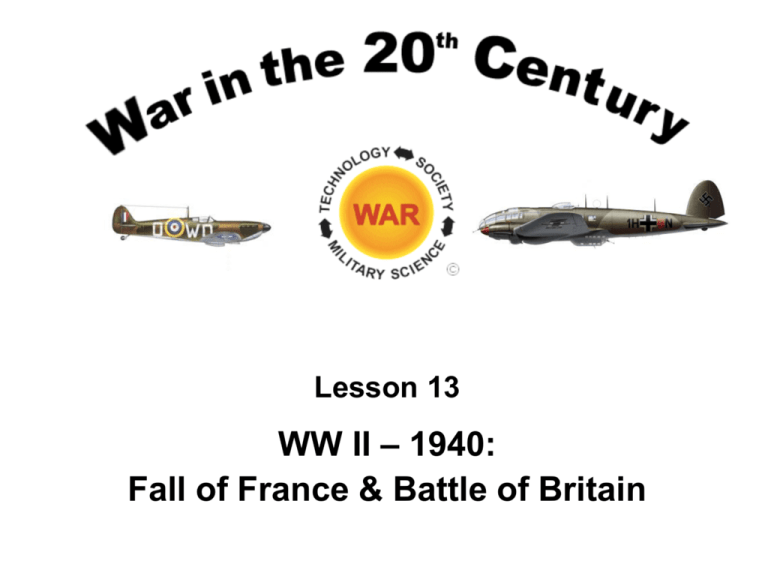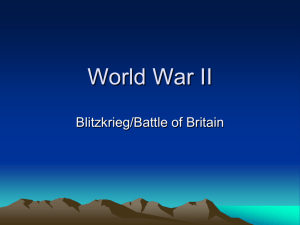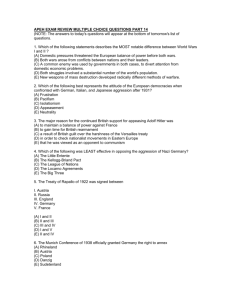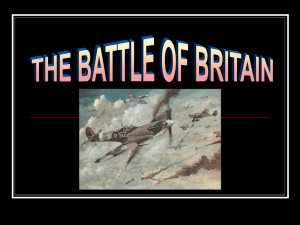13: WW II: 1940: Fall of France & Battle of Britain
advertisement

Lesson 13 WW II – 1940: Fall of France & Battle of Britain Lesson Objectives • Describe the sequence and implications of events from the invasion of Poland to the fall of France. • Be able to describe and analyze the German strategy in the Battle of Britain. • Describe the impact of new technology on the Battle of Britain. • Begin to understand the implications of strategic air warfare in World War II. Events September 1, 1939 Germany invades Poland September 3, 1939 Britain, France declare war on Germany “Phony war” begins April 9, 1940 Germany invades Denmark & Norway May 10, 1940 Germany invades Belgium, Netherlands, Luxembourg Chamberlain resigns * Churchill becomes PM * Britain occupies Iceland * * Not related to invasion Battle of France French Plan Dyle Plan 1939 Schlieffen Plan 1914 Manstein Plan Events September 1, 1939 Germany invades Poland September 3, 1939 Britain, France declare war on Germany “Phony war” begins April 9, 1940 Germany invades Denmark & Norway May 10, 1940 Germany invades Belgium, Netherlands, Luxembourg May 27-29, 1940 Evacuation of Dunkirk Dunkirk May 26-31, 1940 Dunkirk Trapped on the beach German Halt at Dunkirk German army had little amphibious experience • Looked at the Channel as a barrier • Didn’t believe British could possibly get away Panzer units arrived well ahead of the infantry • Were exhausted, out of supply • Called halt to rest, resupply, allow infantry to catch up Luftwaffe hadn’t gotten much credit in battle • Asked for and received permission to destroy BEF British saw Channel as a highway - organized evacuation Withdraw to Dunkirk (1:32:09 – 1:35:35) "The Circle of Modern War" and logo © Thomas D. Pilsch 2007-2013 Miracle of Dunkirk “The Small Ships” Miracle of Dunkirk 300,000+ rescued Equipment abandoned Evacuation at Dunkirk Evacuation at Dunkirk The troops were saved to fight another day .. but their equipment was left behind Evacuation From Dunkirk May 26-31, 1940 (1:35:40 - 1:44:45) "The Circle of Modern War" and logo © Thomas D. Pilsch 2007-2013 Myth Mechanized Juggernaut Reality 3/4 of German infantry moved by foot or horse Battle of France First Phase 4-14 June 1940 Battle of France 4-22 June 1940 Events September 1, 1939 Germany invades Poland September 3, 1939 Britain, France declare war on Germany “Phony war” begins April 9, 1940 Germany invades Denmark & Norway May 10, 1940 Germany invades Belgium, Netherlands, Luxembourg May 27-29, 1940 Evacuation of Dunkirk June 4-22, 1940 Battle of France June 22, 1940 France Surrenders France Surrenders French surrendered at Compiègne – June 20, 1940 Fall & Occupation of France (one opinion) (0 – 4:10 & 4:11-10:00) "The Circle of Modern War" and logo © Thomas D. Pilsch 2007-2013 Britain Stands Alone “Very well, Alone!” Winston S. Churchill Sandhurst (1894) Served in Sudan (1898), the Second Boer War (1899-1900), the Western Front (1915-1916) First elected to Parliament (1900) First Lord of the Admiralty (1911-1915 and 1939-1940) Prime Minister May 10, 1940 - July 27, 1945 * 1874-1965 Led Great Britain during its darkest hour. * Also October 26, 1951 - April 17, 1955 Britain At Bay Battle of Britain "What General Weygand called the Battle of France is over. The Battle of Britain is about to begin." Winston Churchill June 18, 1940 Full Speech (external, 6:08) Excerpt-LoC Excerpt (internal, 1:35) Battle of Britain Background Operation Seelöwe (Sea Lion) Battle of Britain Background Operation Seelöwe (Sealion) Operation Seelöwe Invasion barges in Channel ports July 1940 Operation Sealion Germans began planning for invasion in November 1939 Initial criteria for success: * The Royal Navy had to be eliminated. * The Royal Air Force (RAF) air strength had to be eliminated. * British coastal defenses had to be destroyed. * British submarine action against landing forces had to be prevented. First Law of Modern War The air battle must be won if the war is to be won. General of the Army Omar Bradley November 1951 USAF Doctrine (modern) Priorities for tactical (theater) airpower: 1. Air Superiority 2. Interdiction 3. Close Air Support Operation Sealion Defeat of the Royal Navy in the invasion area required control of the air Hitler’s conditions for Sealion: The RAF is to be "beaten down in its morale and in fact, that it can no longer display any appreciable aggressive force in opposition to the German crossing". Warning Order for Seelöwe, 16 July 1940 Operation Sea Lion 1940 German Plan Take control of the air Defeat the RAF Isolate the invasion area Neutralize Royal Navy, destroy communications & defenses Invade England Land Panzers to employ Blitzkrieg tactics Source: Royal Air Force Battle of Britain 1940 Orders of Battle RAF Luftwaffe Single-seat fighters 754 1,107 Twin-seat fighter 159 357 Bombers 560 1,300 / 428* Maritime patrol 500 233 * Dive-bombers Source German Fighters Messerschmitt Bf 110 "Zerstörer" German Fighters Messerschmitt Bf 109 Most widely produced aircraft in WW II (33,000+ units) British Fighter Supermarine Spitfire British Fighter Hawker Hurricane Spitfire vs. Bf 109 Generally felt to be evenly matched More rugged Higher maximum dive speed Better handling characteristics Heavy on controls at high speed Better visibility Heavier armament (cannon) Source German Bombers Heinkle He 111 Dornier Do 17 Junkers Ju 88 Battle of Britain 1940 Orders of Battle RAF Luftwaffe Single-seat fighters 754 1,107 Twin-seat fighter 159 357 Bombers 560 1,300 / 428* Maritime patrol 500 233 * Dive-bombers Source Battle of Britain British Challenge: How to overcome a numerical disadvantage Principles of War • Objective • Offensive • Mass • Economy of Force • Maneuver • Unity of Command • Security • Surprise • Simplicity Principles of War • Objective • Offensive • Mass • Economy of Force • Maneuver • Unity of Command • Security • Surprise • Simplicity Early Warning System Ground Observers Source: Royal Air Force Battle Management Source: Royal Air Force Battle of Britain Chain Home Radar Site - Dover Battle of Britain Chain Home Radar Towers Chain Home RDF Source: Royal Air Force Alignment of Forces Source Alignment of Forces Source Battle of Britain: Phase I Attacks on Channel Ports and Shipping 10 July –12 August Source: Royal Air Force Junkers Ju 87 Stuka Problem: They were vulnerable to fighters Junkers Ju 87 “Stuka” Battle of Britain: Phase II Attacks on RAF: Fighter Bases, Radar 12 August – 6 September Source: Royal Air Force The Fog of War August 24, 1940 Luftwaffe bomber crews mistakenly bombed London • Residential area August 25 RAF bombers hit Berlin industrial area in retaliation August 26 Enraged, Hitler orders massive attacks against London and other British cities Attacks on cities continue into the fall, switching to night raids after September 15th Significance: Gave the RAF a critically needed breather Battle of Britain: Phase III Daylight Attacks on Cities & Industrial Areas 7 September- 5 October Source: Royal Air Force Battle of Britain: Phase III London’s East End Burning - September 7, 1940 Attacks on British Cities September 7, 1940 - May 10, 1941 “The Blitz” St. Paul’s Cathedral, 26 December 1940 London experienced 57 consecutive nights of bombing • September - November 1940 Over 41,000 civilians killed, 137,000 injured throughout Britain Source Climax September 15, 1940 Massive daylight raid on London • Largest to date 56 German aircraft lost versus 28 RAF fighters RAF used every fighter in 11 Group (no reserves) Germans switched to night raids on cities Considered the turning point of the battle Climax September 15, 1940 September 15th is celebrated as Battle of Britain Day RAF Battle of Britain Memorial Flight Battle of Britain Action "The Circle of Modern War" and logo © Thomas D. Pilsch 2007-2013 Battle of Britain: Phase IV Night Attacks on Cities & Industrial Areas 6 October 1940 - 10 May 1941 (unofficially) Source: Royal Air Force Battle of Britain Operation Sealion September 17, 1940 Operation Sealion postponed indefinitely October 31, 1940 Battle of Britain declared over by Air Ministry Night bombings of cities continued through winter Bad Weather Operations Knickebein (Crocked Leg) Navigation System Source Coventry Industrial city in the midlands Subjected to a massive air raid (400+) on November 14, 1940 Center city and cathedral wiped out 1,400 killed or injured Myth: Churchill knew about raid but could not act to defend Coventry c 1880 Cathedral of Saint Michael Coventry X-Gerät Navigation Aid Battle of Britain Summary Source Battle of Britain 1940 Orders of Battle RAF Luftwaffe Single-seat fighters 754 1,107 Twin-seat fighter 159 357 Bombers 560 1,300 / 428* Maritime patrol 500 233 * Dive-bombers Source Battle of Britain 1940 Losses RAF Single-seat fighters } Luftwaffe 1,023 1,107 Bombers 376 357 Maritime patrol 148 1,014 520 2,600+ Twin-seat fighter Pilots Lost Source Total War “… the whole population … committed to total victory” Princess Elizabeth - Age 17 Battle of Britain Did the British Win or the Germans Lose? Principles of War • Objective • Offensive • Mass • Economy of Force • Maneuver • Unity of Command • Security • Surprise • Simplicity Principles of War • Objective • Offensive • Mass • Economy of Force • Maneuver • Unity of Command • Security • Surprise • Simplicity Battle of Britain Factors British use of radar (command & control) • Allowed RAF to concentrate scarce resources where needed • Allowed RAF to hold aircraft on ground until last moment Battle of Britain Factors British use of radar (command & control) German underestimation of RAF strength • Initial fighter strength • Fighter production capabilities Battle of Britain Factors British use of radar (command & control) German underestimation of RAF strength British “home field” advantage • Fighting close to home airfields • Closer to the fight, more combat time • RAF pilots shot down had a good chance of returning to the fight Battle of Britain Factors British use of radar (command & control) German underestimation of RAF strength British “home field” advantage German loss of focus (Change of Objective) Battle of Britain Did the British Win or the Germans Lose? First Law of Modern War First of all, you must win the battle of the air. That must come before you start a single land or sea engagement. Field Marshal Bernard Law Montgomery, 1943 Lesson 14 WW II -- Second Battle of the Atlantic Lesson Objectives • Understand the magnitude and significance of the Battle of the Atlantic during World War II. • Understand the degree of British dependence on maritime lines of communication. • Describe U.S. participation in the Battle of the Atlantic prior to December 1941. • Describe and analyze the tactics and technology used by both sides in the Battle of the Atlantic. • Understand the importance of code breaking in the Atlantic war. End Video Title "The Circle of Modern War" and logo © Thomas D. Pilsch 2007-2013




